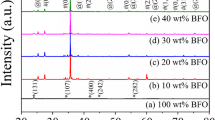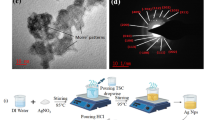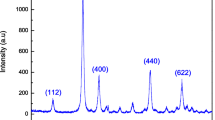Abstract
In this article, the aim is to establish the correlation between the calcination temperature and dielectric properties of BaTiO3 nanoparticles including gas sensing properties. For this purpose, the BaTiO3 nanoparticles have been synthesized using the sol–gel method with low-temperature hydrolysis with varying calcination temperature and time. The structural, morphological, elemental, chemical, dielectric and gas sensing properties have been characterized using XRD, SEM, TEM, EDX, RAMAN Spectroscopy and LCR Meter with Gas Sensing Unit. The cubic phase of BaTiO3 nanoparticles has been confirmed by XRD and the estimated particle size obtained from 20.6 nm to 29.4 nm concerning the change in calcination temperature and time. The morphological study and crystal structure analysis have been performed using SEM and TEM images. Elemental identification has been done by EDX which indicates the presence of Ba, Ti and O in the synthesized compound. The formation of the cubic phase has also been confirmed by Raman analysis with a small shift in peaks toward the higher wave number side. Dielectric properties of synthesized BaTiO3 nanoparticles have been investigated as a function of frequency with temperature variation from 30 to 150 °C. The sensitivity (%) as a function of flow rate and temperature of BaTiO3 nanoparticles have been investigated and observed that BaTiO3 nanoparticles calcinated at 800 °C for 2 h achieved the highest response toward NH3 gas.










Similar content being viewed by others
References
A.L. Kozlovskiy, I.E. Kenzhina, M.V. Zdorovets, M. Saiymova, D.I. Tishkevich, S.V. Trukhanov, A.V. Trukhanov, Synthesis, phase composition and structural and conductive properties of ferroelectric microparticles based on ATiOx (A= Ba, Ca, Sr). Ceram. Int. 45, 17236–17242 (2019)
M.M. Vijatović, J.D. Bobić, B.D. Stojanović, History and challenges of barium titanate: Part II. Sci. Sinter. 40, 235–244 (2008)
B.A. Hernandez, K.S. Chang, E.R. Fisher, P.K. Dorhout, Sol−gel template synthesis and characterization of BaTiO3 and PbTiO3 nanotubes. Chem. Mater. 14, 480–482 (2002)
O.A. Harizanov, Formation and crystallization of an acetate-acetylacetonate derived sol–gel BaTiO3. Mat. Lett. 34, 345–350 (1998)
L. Wu, M.C. Chure, K.K. Wu, W.C. Chang, M.J. Yang, W.K. Liu, M.J. Wu, Dielectric properties of barium titanate ceramics with different materials powder size. Ceram. Int. 35, 957–960 (2009)
L.S. Seveyrat, A. Hajjaji, Y. Emziane, B. Guiffard, D. Guyomar, Re-investigation of synthesis of BaTiO3 by conventional solid-state reaction and oxalate coprecipitation route for piezoelectric applications. Ceram. Int. 33, 35–40 (2007)
R. Ashiri, Detailed FT-IR spectroscopy characterization and thermal analysis of synthesis of barium titanatenanoscale particles through a newly developed process. Vib. Spect. 66, 24–29 (2013)
P.P. Phule, S.H. Risbud, Sol-gel synthesis of barium titanate powders using barium acetate and titanium (IV) isopropoxide. Adv. Ceram. Mater. 3, 183–185 (1988)
N.B. Mahmood, E.K. Al-Shakarchi, Three techniques used to produce BaTiO3 fine powder. J. Modern Phys. 2, 1420–1428 (2011)
G.H. Jain, L.A. Patil, M.A. Wagh, D.R. Patil, S.A. Patil, Surface modified BaTiO3 thick film resistors as H2S gas sensors. Sens. Actuators B 117, 159–165 (2006)
G.H. Jain, S.B. Nahire, D.D. Kajale, G.E. Patil, S.D. Shinde, D.N. Chavan, V.B. Gaikwad, Cr2O3-Doped BaTiO3 as an Ammonia Gas Sensor (Springer, Berlin, 2011).
R. Ashiri, A. Nemati, M. Sasani Ghamsari, M.M. Dastgahi, Nanothickness films, nanostructured films, and nanocrystals of barium titanate obtained directly by a newly developed sol–gel synthesis pathway. J. Mater. Sci. Mater. Elect. 25, 5345–5355 (2014)
B.D. Cullity, Elements of X-Ray Diffraction (Addison-Wesley, Reading, 1978).
W.H. Zhang, L. Chen, Y.T. Tao, J. Chen, J.X. Zhang, Raman study of barium titanate with oxygen vacancies. Phys. B: Cond. Matter 406, 4630–4633 (2011)
A.V. Zanfir, G. Voicu, S.I. Jinga, E. Vasile, V. Ionita, Low-temperature synthesis of BaTiO3 nanopowders. Ceram. Int. 42, 1672–1678 (2016)
H. Pawar, M. Khan, C. Mitharwal, U.K. Dwivedi, S. Mitra, D. Rathore, Co1−xBaxFe2O4 (x= 0, 0.25, 0.5, 0.75 and 1) nanoferrites as gas sensor towards NO2 and NH3 gases. RSC Adv. 10, 35265–35272 (2020)
D. Rathore, R. Kurchania, R.K. Pandey, Structural, magnetic and dielectric properties of Ni1-xZnxFe2O4 (x = 0, 0.5 and 1) nanoparticles synthesized by chemical co-precipitation method. Int. J. Nanosci. Nanotech. 13, 1812–1819 (2013)
D. Rathore, R. Kurchania, R.K. Pandey, Influence of particle size and temperature on the dielectric properties of CoFe2O4 nanoparticles. Int. J. Min. Metal. Mater. 21, 408–414 (2014)
M. Khan, H. Pawar, M. Kumari, C. Patra, G. Patel, U.K. Dwivedi, D. Rathore, Effect of concentration of SiC on physicochemical properties of CoFe2O4/SiC nanocomposites. J. Alloys Compd. 840, 155596 (2020)
A. Hendi, AC conductivity and dielectric measurements of bulk tertracyanoquinodimethane. Aust. J. Basic Appl. Sci. 5, 380–386 (2011)
Y. Usman, G.S. Chung, Effect of surface treated MWCNTs and BaTiO3 nanoparticles on the dielectric properties of a P (VDF-TrFE) matrix. J. Alloys Compd. 695, 1231–1236 (2017)
P. Tyagi, A. Sharma, M. Tomar, V. Gupta, Metal oxide catalyst assisted SnO2 thin film based SO2 gas sensor. Sens. Actuators B 224, 282–289 (2016)
D. Rathore, S. Mitra, R. Kurchania, R.K. Pandey, Physicochemical properties of CuFe2O4 nanoparticles as a gas sensor. J. Mater. Sci.: Mater. Electr. 29, 1925–1932 (2018)
D. Rathore, R. Kurchania, R.K. Pandey, Gas sensing properties of size varying CoFe2O4 nanoparticles. IEEE Sens. J. 15, 4961–4966 (2015)
D. Rathore, S. Mitra, MnFe2O4 as a gas sensor towards SO2 and NO2 gases. AIP Conf. Proc. 1728, 020166-1–20173 (2016)
D. Rathore, R. Kurchania, R.K. Pandey, Fabrication of Ni1−xZnxFe2O4 (x= 0, 0.5 and 1) nanoparticles gas sensor for some reducing gases. Sens. Actuators A Phys. 199, 236–240 (2013)
G. Qiu, Z. Gai, Y. Tao, J. Schmitt, G.A. Kullak-Ublick, J. Wang, Dual-functional plasmonic photothermal biosensors for highly accurate severe acute respiratory syndrome coronavirus 2 detection. ACS Nano 14, 5268–5277 (2020)
Acknowledgements
The authors would like to thanks to funding agencies for SERB funded Project No. EMR/2016/2156 and UGC, DAE-CSR, Indore for CRS funded Project No. CSR-IC/MSRSR-10/CRS-218/2017-18/1299.
Author information
Authors and Affiliations
Corresponding author
Additional information
Publisher's Note
Springer Nature remains neutral with regard to jurisdictional claims in published maps and institutional affiliations.
Rights and permissions
About this article
Cite this article
Pawar, H., Khan, M., Kumari, M. et al. Role of calcination on dielectric properties of BaTiO3 nanoparticles as a gas sensor. Appl. Phys. A 127, 384 (2021). https://doi.org/10.1007/s00339-021-04517-6
Received:
Accepted:
Published:
DOI: https://doi.org/10.1007/s00339-021-04517-6




